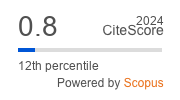Nonlinear dynamic approach to the analysis of memristor parameters instability
https://doi.org/10.17073/1609-3577-2019-4-253-261
Abstract
However, a compact model is further developed in which the state of such a network is aggregated to three phase variables: the length of the filament, its total charge, and the local temperature. Despite the apparent physical meaning, all variables have a formal character, which is usually inherent in the parameters of compact models. The model consists of one algebraic equation, two differential equations, and one integral connection equation, and is derived from the simplest Strukov’s model. Therefore, it uses the “window function” approach. It is indicated that, according to the Poincare—Bendixon theorem, this is sufficient to explain the instability of four key parameters (switching voltages and resistances ON/OFF) at a cycling of memristor. The Fourier spectra of the time series of these parameters are analyzed on a low sample of experimental data. The data are associated with the TiN/HfOx/Pt structure (0 < x < 2). A preliminary conclusion that requires further verification is the predominance of low frequencies and the stochasticity of occurrence ones.
About the Author
I. V. MatyushkinRussian Federation
Igor V. Matyushkin: Cand. Sci. (Phys.-Math.), Senior Researcher
References
1. Tarkov M. S. Implementation of a neural WTA-network on the memristor crossbar. Prikl. Diskr. Mat. Suppl., 2015, no. 8, pp. 151—154. (In Russ.). DOI: 10.17223/2226308X/8/59
2. Wang Z., Wu H., Burr G. W., Hwang C. S., Wang K. L., Xia Q., Yang J. J. Resistive switching materials for information processing. Nature Rev. Mater., 2020, vol. 5, pp. 173—195. DOI: 10.1038/s41578-019-0159-3
3. Zhao M., Gao B., Tang J., Qian H., Wu H. Reliability of analog resistive switching memory for neuromorphic computing. Appl. Phys. Rev., 2020, vol. 7, no. 1, p. 011301(16pp.). DOI: 10.1063/1.5124915
4. Benderli S. Wey T. A. On SPICE macromodeling of TiO2 memristors. Electronics Lett., 2009, vol. 45, no. 7, pp. 377—379. DOI: 10.1049/EL.2009.3511
5. Pickett M. D., Strukov D. B., Borghetti J. L., Yang J. J., Snider G. S., Stewart D. R., Williams R. S. Switching dynamics in titanium dioxide memristive devices. J. Appl. Phys., 2009, vol. 106, no. 7, p. 074508. DOI: 10.1063/1.3236506
6. Yakopcic C., Taha T. M., Subramanyam G., Pino R. E., Rogers S. A memristor device model. IEEE Electron Device Letters, 2011, vol. 32, no. 10, pp. 1436—1438. DOI: 10.1109/LED.2011.2163292
7. Chua L. Memristor. The missing circuit element. IEEE Transactions on Circuit Theory, 1971, vol. 18, no. 5, pp. 507—519. DOI: 10.1109/TCT.1971.1083337
8. Chang H., Song Q., Li Y., Wang Z., Chen G. Unstable limit cycles and singular attractors in a two-dimensional memristor-based dynamic system. Entropy, 2019, vol. 21, no. 4, p. 415 (10pp.). DOI: 10.3390/e21040415
9. Mikheev R., Teplov G., Matyushkin I. Compact model of nonlinear dynamics while the cycling of a memristor. In: 2019 IEEE Conference of Russian Young Researchers in Electrical and Electronic Engineering (EIConRus). St. Petersburg; Moscow (Russia), 2019, pp. 2057—2061. DOI: 10.1109/EIConRus.2019.8657191
10. Pershin Y. V., Slipko V. A. Dynamical attractors of memristors and their networks. EPL (Europhysics Letters), 2019, vol. 125, no. 2, p. 20002. DOI: 10.1209/0295-5075/125/20002
11. Pershin Y. V., Slipko V. A. Bifurcation analysis of a TaO memristor model. J. Phys. D: Appl. Phys., 2019, vol. 52, no. 50, p. 505304. DOI: 10.1088/1361-6463/ab4537
12. Crutchfield J. P., Young K. Computation at the onset of chaos. In: Entropy, Complexity, and the Physics of Information. Ed. by W. Zurek. Addison-Wesley, Reading, 1990, pp. 223—269. URL: http://csc.ucdavis.edu/~cmg/papers/CompOnset.pdf
13. Csaba G., Porod W. Coupled oscillators for computing: A review and perspective. Appl. Phys. Rev., 2020, vol. 7, no. 1, p. 011302. DOI: 10.1063/1.5120412
14. Malagarriga D., García-Vellisca M. A., Villa A. E. P., Buldú J. M., García-Ojalvo J., Pons A. J. Synchronization-based computation through networks of coupled oscillators. Front. Comput. Neurosci., 2015, vol. 9, p. 97(13pp.). DOI: 10.3389/fncom.2015.00097
15. Islamov D. R., Gritsenko V. A., Perevalov T. V., Pustovarov V. A., Orlov O. M., Chernikova A. G., Markeev A. M., Slesazeck S., Schroeder U., Mikolajick T., Krasnikov G. Ya. Identification of the nature of traps involved in the field cycling of Hf0.5Zr0.5O2-based ferroelectric thin films. Acta Materialia, 2019, vol. 166, pp. 47—55. DOI: 10.1016/j.actamat.2018.12.008
16. Panda D., Sahu P. P., Tseng T. Y. A collective study on modeling and simulation of resistive random access memory. Nanoscale Res. Lett., 2018, vol. 13, no. 1, art. no. 8. DOI: 10.1186/s11671-017-2419-8
17. Miritello G., Pluchino A., Rapisarda A. Central limit behavior in the Kuramoto model at the “Edge of Chaos”. Physica A: Statistical Mechanics and its Applications, 2009, vol. 388, no. 23, pp. 4818—4826. DOI: 10.1016/j.physa.2009.08.023
18. Everhardt A. S., Damerio S., Zorn J. A., Zhou S., Domingo N., Catalan G., Salje E. K. H., Chen L.-Q., Noheda B. Periodicity-doubling cascades: direct observation in ferroelastic materials. Phys. Rev. Lett., 2019, vol. 123, no. 8, p. 087603(6pp.). DOI: 10.1103/PhysRevLett.123.087603
19. Orlov O., Murashev V., Lebedev A., Orlov V., Ivanov S. Features of the improving of the HFO2 ReRAM cells characteristics reproducibility. In: 2019 IEEE Conference of Russian Young Researchers in Electrical and Electronic Engineering (EIConRus). St. Petersburg; Moscow (Russia), 2019, pp. 2087—2089. DOI: 10.1109/EIConRus.2019.8657230
20. Strukov D. B., Snider G. S., Stewart D. R., Williams R. S. The missing memristor found. Nature, 2008, vol. 453, pp. 80—83. DOI: 10.1038/nature06932
21. Kim S., Kim H.-D., Choi S.-J. Compact two-state-variable second-order memristor model. Small, 2016, vol. 12, no. 24, pp. 3320—3326. DOI: 10.1002/smll.201600088
Review
For citations:
Matyushkin I.V. Nonlinear dynamic approach to the analysis of memristor parameters instability. Izvestiya Vysshikh Uchebnykh Zavedenii. Materialy Elektronnoi Tekhniki = Materials of Electronics Engineering. 2019;22(4):253-261. (In Russ.) https://doi.org/10.17073/1609-3577-2019-4-253-261





































